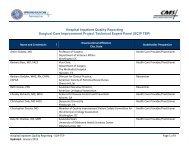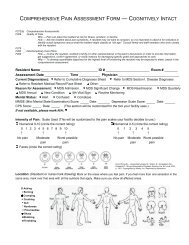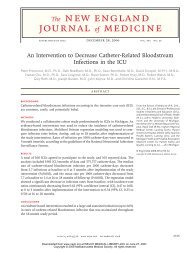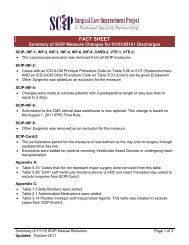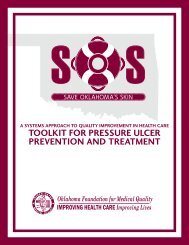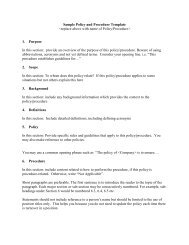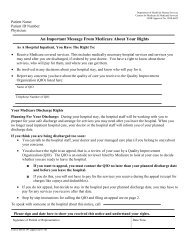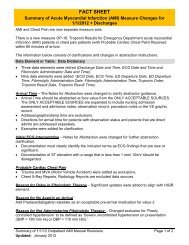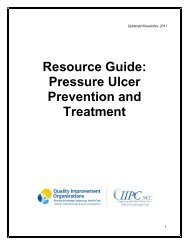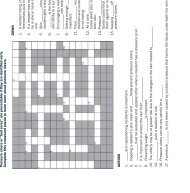Pressure Ulcer Brochure - Oklahoma Foundation for Medical Quality
Pressure Ulcer Brochure - Oklahoma Foundation for Medical Quality
Pressure Ulcer Brochure - Oklahoma Foundation for Medical Quality
Create successful ePaper yourself
Turn your PDF publications into a flip-book with our unique Google optimized e-Paper software.
Physicians, Reduce Your Risk And Improve Care<br />
2.5 million patients are treated <strong>for</strong> pressure ulcers every<br />
With these <strong>for</strong>midable costs, pain and suffering, and potential<br />
year 1 . The national cost of care exceeds $11 billion each<br />
<strong>for</strong> litigation, it’s time to give the skin the attention it<br />
year 2 , with an average DRG payment of $43,180 per patient deserves, and reduce your risk. This guide presents the latest<br />
<strong>for</strong> treatment. 3 Serious pressure ulcers are considered a “never science and recommendations <strong>for</strong> incorporating principles of<br />
event” among hospital-acquired conditions with payment<br />
pressure ulcer prevention into everyday practice and<br />
implications.<br />
using appropriate treatment methodology. For more detailed<br />
in<strong>for</strong>mation, visit http://www.ofmq.com/sos-tools.<br />
“Doctor, Please Look At Me”<br />
Skin assessment <strong>for</strong> high-risk individuals should be part of<br />
your routine practice. It doesn’t take an expensive CAT Scan,<br />
MRI, endoscopy or even a lab test! Almost 90% of pressure<br />
ulcers occur in the posterior pelvic region and the heel/ankle<br />
region. It is particularly essential to assess these pressure points<br />
on elderly and immobile patients. It takes 2-3 minutes to assess<br />
as preventable and primarily reversible affliction.<br />
<strong>Pressure</strong> ulcers that<br />
reach full thickness<br />
damage (stages 3&4) will<br />
never heal beyond 80%<br />
tensile strength. Assess<br />
the skin early and often<br />
to prevent worsening of<br />
pressure ulcers.<br />
The Best Treatment Is Prevention<br />
Who Is At Risk<br />
High Risk Factors <strong>for</strong> <strong>Pressure</strong> <strong>Ulcer</strong> Patients<br />
• Elderly<br />
• Immobile<br />
• Neurologically Impaired<br />
• Prolonged OR Time<br />
• Time in ER<br />
• Complicated Hospital Course<br />
• Co-morbidities (diabetes, vascular diseases, renal compromise)<br />
• Chronically Ill<br />
• Obese/Malnourished<br />
• Post-Surgical<br />
• Incontinent<br />
• Chronic Pain<br />
Where To Look<br />
Key Areas Susceptible To <strong>Pressure</strong> <strong>Ulcer</strong>s<br />
• Bony Prominences<br />
• Posterior Pelvic Region<br />
• Heels and Ankles<br />
What To Look For<br />
Conditions That Will Alter Your Plan Of Care<br />
• Be familiar with latest staging guidelines<br />
(http://www.npuap.com)<br />
• Notice reddened areas.<br />
• Learn to differentiate pressure ulcers from other types of<br />
wounds.<br />
• Wounds such as diabetic and neuropathic ulcers and<br />
venous arterial insufficiency ulcers are often incorrectly<br />
classified as pressure ulcers. Misidentifying wound etiology<br />
can lead to an incorrect treatment plan.<br />
• For example: Treating an exudating venous ulcer as a<br />
pressure ulcer will be fruitless. Applying full compression<br />
on a leg without establishing arterial status, such as<br />
with an ankle-brachial index (ABI) or toe-brachial index<br />
(TBI) is negligent.<br />
Opportunities For Assessment<br />
• On admission into acute care - Pre<strong>for</strong>m a head to toe,<br />
front to back assessment. Physician should document<br />
breakdown on admission (consistent with nurse documentation).<br />
• In office - Check sacral area when doing exams such as<br />
rectal and hemocult testing. Assess pressure points on<br />
elderly and immobile patients.<br />
• Be<strong>for</strong>e dictating discharge summary from acute care<br />
- Check <strong>for</strong> skin breakdown. Make arrangements <strong>for</strong><br />
wound care if needed.<br />
• Post surgery - as patient is moved to gurney<br />
“Doctor, Dress Me Up And Treat Me Right”<br />
Gauze For Alarm<br />
Bacteria can pass through 64 layers of gauze. The infection rate with gauze dressings is nearly 3x higher than with moisture retentive<br />
dressings 4 . Wound care experts agree that the use of wet-to-dry mechanical debridement should be restricted to heavily necrotic<br />
wounds and discounted when viable tissue is present 5 .<br />
Modify Don’t Toxify<br />
Do thy patient’s proliferating cells no harm. “Let’s dry them bugs up with betadine and kill ‘em,” is old thinking, not quality wound<br />
care. Historically, antiseptics were used <strong>for</strong> decontaminating infected wounds. Today, (routine use of alcohol, betadine, hydrogen<br />
peroxide, saline solution or acetic acid) is generally discouraged because their cellular toxicity exceed their bactericidal (bacteria killing)<br />
activity 6 .<br />
Time For A Change<br />
No, not likely. Advances in dressings allow us to minimize the frequency of dressing changes. Every time a pressure ulcer dressing is<br />
changed, it takes 4 to 6 hours to regain the ideal healing temperature. Don’t order twice a day or even daily dressing changes unless<br />
they are really needed. However, if a wound has failed to progress over a 2-4 week period, reassess the wound and consider a different<br />
treatment plan. For example, a topical antibiotic or treatment of the epibole may need to be considered.




